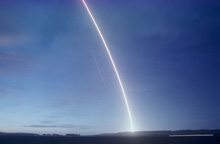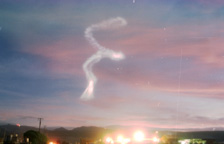
Delta II/Iridium launch, November 8, 1997 |
(Download a higher resolution picture by clicking on any
picture below.) 
On the afternooon of Saturday November 8, 1997, I drove out to the fields west of Lompoc to watch the launch of a Delta II with a cluster of five Motorola Iridium satellites from Space Launch Complex 2 at Vandenberg AFB. The launch occurred just long enough after sunset that the Delta climbed into sunlight about the time that it reached the top of the atmosphere. This provided a rare opportunity to observe the exhaust of the rocket against a dark sky, without sunlight scattered from the intervening atmosphere.
 I couldn't see the launch pad, but the horizon lit up brightly
the moment the solid fuel boosters of the Delta were ignited.
After a period of several seconds the flame of the rocket
appeared over the hills, bright like an arc lamp. The rocket
climbed swiftly, trailing a long orange flame at the top of an
opaque column of smoke. Photographer: Brian Lockett.
I couldn't see the launch pad, but the horizon lit up brightly
the moment the solid fuel boosters of the Delta were ignited.
After a period of several seconds the flame of the rocket
appeared over the hills, bright like an arc lamp. The rocket
climbed swiftly, trailing a long orange flame at the top of an
opaque column of smoke. Photographer: Brian Lockett.
 It pitched over to the south, and accelerated rapidly. The
rocket's flame dimmed as two sets of three solid fuel boosters
burned out and were jettisoned. The flame brightened as three
more boosters ignited. One of the jettisoned boosters could be
seen as an orange spark that flared and dimmed periodically as
the booster tumbled behind the still accelerating Delta. The long
orange flame ceased abruptly and was replaced by a bright blue
point of light as the last three solid fuel boosters burned out
and were jettisoned. Photographer: Brian Lockett.
It pitched over to the south, and accelerated rapidly. The
rocket's flame dimmed as two sets of three solid fuel boosters
burned out and were jettisoned. The flame brightened as three
more boosters ignited. One of the jettisoned boosters could be
seen as an orange spark that flared and dimmed periodically as
the booster tumbled behind the still accelerating Delta. The long
orange flame ceased abruptly and was replaced by a bright blue
point of light as the last three solid fuel boosters burned out
and were jettisoned. Photographer: Brian Lockett.
The rocket was accelerating under the power of its liquid fuel core as it rose out of the earth's shadow and into the sunlight. Ice crystals in the rapidly cooling exhaust refracted the light into iridescent purples, greens, and pinks. The column of smoke over the launch pad was visible only in silhouette against the twilight sky, so the exhaust trail from the vertical ascent of the early part of the launch would not have been evident to observers farther away.
I was taking pictures through an eight-power telephoto lens. At that magnification the Delta took on the appearance of an animated comet. I was looking through the exhaust trail at the departing rocket. The exhaust could be seen expanding away from the rocket engine in all directions and then trailing off, up and to the side, as the Delta headed toward the southern horizon.
 The flame of the rocket engine died out suddenly. The illuminated
portion of the exhaust trail took on the appearance of a
fluorescent line with an expanding cone at the end. The line
began to twist into abstract shapes as the trail was carried into
the earth's shadow. Photographer: Brian Lockett.
The flame of the rocket engine died out suddenly. The illuminated
portion of the exhaust trail took on the appearance of a
fluorescent line with an expanding cone at the end. The line
began to twist into abstract shapes as the trail was carried into
the earth's shadow. Photographer: Brian Lockett.
 Book about
missiles and rockets available from
Book about
missiles and rockets available from 
The Missile and Space Race by Alan J. Levine. Here is a history of the development of military missiles and space travel from World War II to the American visits to the Moon in 1969-1972. It stresses the relationship between the early stages of space exploration and the arms race, and that a dual path led to space flight. One was the development of unmanned long-range war rockets, the other, less often noted, was the rocket-powered research plane. The first path led through the intercontinental ballistic missile to the first artificial satellites and space capsule; the latter, more uniquely American, through the X-series and Skyrocket rocket planes to the X-15, and ultimately to the Space Shuttle. The early part of the book focuses on the Soviet-American race to develop the ICBM in the 1950s, and the first satellites, with particular attention paid to the events and reactions that followed the flight of Sputnik I in 1957 and the subsequent missile gap era.
Link to the home page of the ![]() 30th
Space Wing
30th
Space Wing
Call the Vandenberg Air Force Base Launch Hotline at (805) 606-1857 for current launch schedule information.
 Link to the NASA rocket launch manifest
Link to the NASA rocket launch manifest
For national and international space coverage visit SPACE.com
Brian Webb's Rawhide Space Page provides launch schedule and ham radio information.
Send a message to Brian.
Go to home page of the Goleta Air and Space Museum.